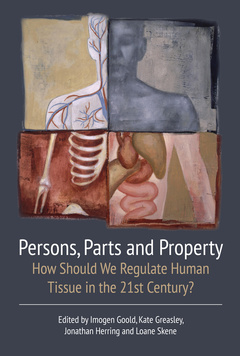Description
Persons, Parts and Property
How Should we Regulate Human Tissue in the 21st Century?
Authors: GOOLD Imogen, SKENE Loane, GREASLEY Kate, HERRING Jonathan
Language: English
Subjects for Persons, Parts and Property :
Approximative price 46.48 €
In Print (Delivery period: 14 days).
Add to cart
Publication date: 09-2016
334 p. · Paperback
334 p. · Paperback
Description
/li>Readership
/li>Biography
/li>
The
debate over whether human bodies and their parts should be governed by the
lawsof property has accelerated with the pace of technological change.
Having long held thata corpse could not be property, the common law first
recognised that there could be aproperty interest in human tissue in some
circumstances in the early 1900s, but it wasnot until a string of judicial
decisions and statutory regulation in the 1990s and early2000s that the
place of this ‘exception’ was cemented. The 2009 decision of the Court
ofAppeal of England and Wales in Yearworth & Ors v North Bristol NHS
Trust added a newdimension to the debate by supporting a move towards
a broader, more principledbasis for finding (or rejecting) property rights
in human tissue. However, the law relatingto property rights in human
bodies and their parts remains highly contested. Thecontributions in this
volume represent a collation of the broad spectrum of analyses onoffer,
and provide a detailed exploration of the salient legal and theoretical
puzzlesarising out of the body-as-property question.
Medical law scholars
Imogen Goold is an Associate Professor in Law at the University of Oxford and a Fellow
of St Anne's College.
Kate Greasley is a Junior Research Fellow in Law at University College, Oxford.
Jonathan Herring is a Professor in Law at the University of Oxford and a Fellow of Exeter College.
Loane Skene is a Professor in Law at the Melbourne Law School and an Adjunct Professor in the Faculty of Medicine, Dentistry and Health Sciences at the University of Melbourne.
Kate Greasley is a Junior Research Fellow in Law at University College, Oxford.
Jonathan Herring is a Professor in Law at the University of Oxford and a Fellow of Exeter College.
Loane Skene is a Professor in Law at the Melbourne Law School and an Adjunct Professor in the Faculty of Medicine, Dentistry and Health Sciences at the University of Melbourne.
© 2024 LAVOISIER S.A.S.

